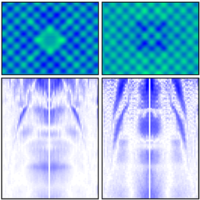当前位置:
X-MOL 学术
›
Phys. Rev. Research
›
论文详情
Our official English website, www.x-mol.net, welcomes your
feedback! (Note: you will need to create a separate account there.)
Projective quasiparticle interference of a single scatterer to analyze the electronic band structure of ZrSiS
Physical Review Research ( IF 3.5 ) Pub Date : 2020-06-30 , DOI: 10.1103/physrevresearch.2.023419 Wenhao Zhang , Kunliang Bu , Fangzhou Ai , Zongxiu Wu , Ying Fei , Yuan Zheng , Jianhua Du , Minghu Fang , Yi Yin
Physical Review Research ( IF 3.5 ) Pub Date : 2020-06-30 , DOI: 10.1103/physrevresearch.2.023419 Wenhao Zhang , Kunliang Bu , Fangzhou Ai , Zongxiu Wu , Ying Fei , Yuan Zheng , Jianhua Du , Minghu Fang , Yi Yin

|
Quasiparticle interference (QPI) of the electronic states has been widely applied in scanning tunneling microscopy to analyze the electronic band structure of materials. Single-defect-induced QPI reveals defect-dependent interaction between a single atomic defect and electronic states, which deserves special attention. Due to the weak signal of single-defect-induced QPI, the signal-to-noise ratio is relatively low in a standard two-dimensional QPI measurement. In this paper, we introduce a projective quasiparticle interference (PQPI) method in which a one-dimensional measurement is taken along high-symmetry directions centered on a specified defect. We apply the PQPI method to the topological nodal-line semimetal ZrSiS. We focus on two special types of atomic defects that scatter the surface and bulk electronic bands. With an enhanced signal-to-noise ratio in PQPI, the energy dispersions are clearly resolved along high-symmetry directions. We discuss the defect-dependent scattering of bulk bands with the nonsymmorphic symmetry-enforced selection rules. Furthermore, an energy shift of the surface floating band is observed, and a branch of energy dispersion () is resolved. This PQPI method can be applied to other complex materials to explore defect-dependent interactions in the future.
中文翻译:

单个散射体的准准粒子干涉分析ZrSiS的电子能带结构
电子态的准粒子干涉(QPI)已广泛应用于扫描隧道显微镜分析材料的电子能带结构。单缺陷诱导的QPI揭示了单个原子缺陷与电子态之间的依赖于缺陷的相互作用,这一点值得特别注意。由于单缺陷诱导QPI的信号较弱,因此在标准二维QPI测量中信噪比相对较低。在本文中,我们介绍了一种射影准粒子干扰(PQPI)方法,其中沿以指定缺陷为中心的高对称方向进行一维测量。我们将PQPI方法应用于拓扑节点线半金属ZrSiS。我们专注于两种特殊类型的原子缺陷,它们会散射表面和整个电子带。通过提高PQPI中的信噪比,可以沿高对称方向清楚地解决能量色散问题。我们讨论了非对称对称强制选择规则对体带的缺陷依赖性散射。此外,观察到表面浮动带的能量移动,并且能量分散的分支()已解决。这种PQPI方法可以应用于其他复杂材料,以在将来探索与缺陷相关的相互作用。
更新日期:2020-06-30
中文翻译:

单个散射体的准准粒子干涉分析ZrSiS的电子能带结构
电子态的准粒子干涉(QPI)已广泛应用于扫描隧道显微镜分析材料的电子能带结构。单缺陷诱导的QPI揭示了单个原子缺陷与电子态之间的依赖于缺陷的相互作用,这一点值得特别注意。由于单缺陷诱导QPI的信号较弱,因此在标准二维QPI测量中信噪比相对较低。在本文中,我们介绍了一种射影准粒子干扰(PQPI)方法,其中沿以指定缺陷为中心的高对称方向进行一维测量。我们将PQPI方法应用于拓扑节点线半金属ZrSiS。我们专注于两种特殊类型的原子缺陷,它们会散射表面和整个电子带。通过提高PQPI中的信噪比,可以沿高对称方向清楚地解决能量色散问题。我们讨论了非对称对称强制选择规则对体带的缺陷依赖性散射。此外,观察到表面浮动带的能量移动,并且能量分散的分支()已解决。这种PQPI方法可以应用于其他复杂材料,以在将来探索与缺陷相关的相互作用。











































 京公网安备 11010802027423号
京公网安备 11010802027423号